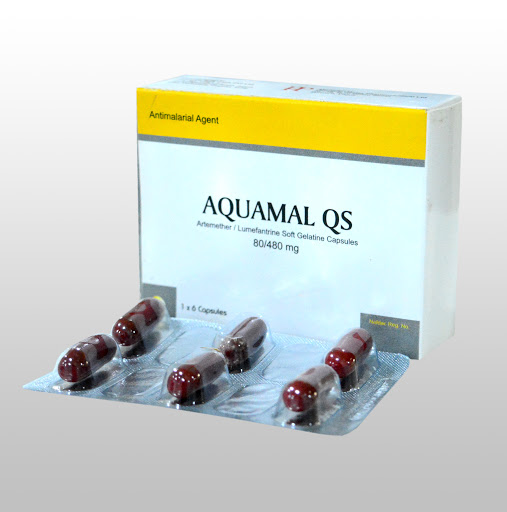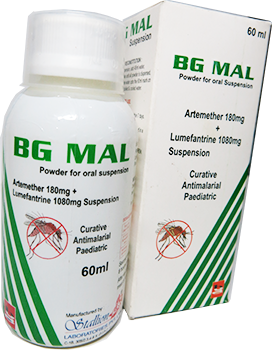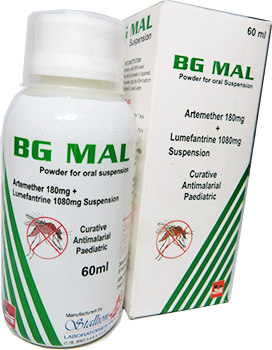PHARMACODYNAMICS:
Aquamal QS comprises a fixed combination of 1 part of Artemether and 6 parts of Lumefantrine. Artemether has quick onset of action while Lumefantrine has longer duration of action. Both exerts their anti-parasitic action at the blood stage of malarial parasite, where they convert the haem (a toxic metabolite produced during haemoglobin breakdown) to nontoxic haemozoin (malaria pigment).
Lumefantrine interfaces with the polymerization process, while Artemether generates reactive metabolites as a result of interaction between its peroxide bridge & haem iron. Both components also have a secondary action involving inhibition of nucleic acid and protein synthesis within the malarial parasite. There is a synergism of independant actions of both Artemether and Lumefantrine, which has been shown to potentiate the blood schizontocidal effects. It is also effective against drug resistant strains of P. falciparum malaria.
Comprehensive in vitro studies using laboratory maintained and fresh field parasite isolates from different malaria endemic areas have shown marked synergic effect of these two components. Results of comparative clinical trials indicate that this Artemether and Lumefantrine combination also clears gametocytes more rapidly than other conventional antimalarials.
PHARMACOKINETICS:
ABSORPTION: Artemether is absorbed quickly with peak plasma concentrations reaching in about 2 hours after dosing, while absorption of Lumefantrine is started after a lag-time of up to 2 hours, with peak plasma concentration in about 6-8 hours after dosing. Food enhances the absorption of Artemether & Lumefantrine. In healthy volunteers the relative bioavailability of Lumefantrine increases sixteen fold compared with intake on empty stomach.
High fat content is conducive for absorption. Food has also been shown to increase the absorption of Lumefantrine in patients with malaria. Usually in acutely ill patients there is a tendency of consuming low fat diet. Absorption of Lumefantrine under fasted conditions is very poor. Patients should therefore be encouraged to take the medication with a normal diet as soon as food can be tolerated.
DISTRIBUTION: Artemether and Lumefantrine are both highly bound to human serum proteins in vitro (95.4% and 99.9%, respectively). Artemether is well distributed throughout the body with some affinity for the brown fat and adrenal glands, while Lumefantrine has an affinity for adipose and glandular tissue and to some extent for the lungs, spleen (due to slow elimination from lymphoid tissue) and bone marrow
METABOLISM: Artemether is rapidly and extensively metabolized in human liver microsomes to the biologically active main metabolite dihydroartemisinin (demethylation), predominantly through the enzyme system CYP3A4. Lumefantrine is also metabolized by CYP3A4 in human liver microsomes, where glucuronidation of Lumefantrine takes place directly, after the oxidative biotransformation. However, Lumefantrine inhibits the cytochrome enzyme CYP2D6
ELIMINATION: Artemether is rapidly cleared from plasma with an elimination half-life of about 2 – 3 hours. Lumefantrine is eliminated very slowly with a elimination half-life of 4 – 6 days in patients with falciparum malaria. Demographic characteristics such as sex and weight appear to have no clinically relevant effects on the pharmacokinetics of Artemether / Lumefantrine.
Unchanged Artemether has not been detected in faeces and urine due to its rapid and high-first-pass metabolism, but several metabolites (unidentified) have been detected in both faeces and urine. Lumefantrine is eliminated via the bile in animals with excretion primarily in the faeces. After oral dosing in animals qualitative and quantitative recovery of metabolites in bile and faeces was relatively low, most of the dose being recovered as parent drug.
Indications
Artemether / Lumefantrine is indicated for the treatment of uncomplicated P. falciparum malaria including multi-drug resistant strains of P. falciparum. Aquamal QS is also effective against the blood stage of P. vivax but not active against hypnozoites.
Artemether / Lumefantrine must be used for the malaria infections acquired in areas where the parasites may be resistant to other anti-malarial drugs. World Health Organization recommends Artemether / Lumefantrine as a first line treatment for the acute uncomplicated P. falciparum malaria for both multi-drug resistant areas & drug sensitive areas.
Contra-indications
Artemether / Lumefantrine is contra-indicated to those patients which have a history of hypersensitivity to Artemether / Lumefantrine
Precautions/Warnings
Pregnancy: There are no adequate data from the use of Artemether / Lumefantrine in pregnant women. Artemether / Lumefantrine treatment should only be considered if the expected benefit to the mother outweighs the risk to the fetus
Lactation: Artemether / Lumefantrine excretes into breast milk. It should not be taken by breast-feeding women
Interactions
Patients who are taking any drug which inhibits the cytochrome enzyme CYP3A4 (e.g. erythromycin, ketoconazole, itraconazole, cimetidine, HIV protease inhibitor, etc.)
Patients who are taking any drug which is metabolized by the cytochrome enzyme CYP2D6 (e.g. flecainide, metoprolol, imipramine, amitryptyline, clomipramine etc.)
Adverse Effects
Artemether / Lumefantrine is well tolerated and there is no drug induced serious unwanted side effects.
The most common adverse experiences (> 1%) in patients treated with Artemether / Lumefantrine combination are abdominal pain, diarrhoea, vomiting, nausea, palpitation, headache, dizziness, arthralgia, cough, myalgia, pruritis, rash, asthenia and fatigue
The preclinical investigations and the clinical trial programs revealed no cardiotoxicity with Artemether / Lumefantrine combination, and to date there have been no reports of adverse clinical cardiac events.
Recent studies comparing Artemether / Lumefantrine with Halofantrine in human showed a clear distinction between the two substances and confirmed no sign of cardiotoxicity with Artemether / Lumefantrine combination
Dosage & Administration
Patients with acute malaria are frequently averse to food.
The dose may be encouraged to resume normal eating as soon as food can be tolerated since this improves absorption of Artemether and Lumefantrine.
In the event of vomiting within 1 hour of administration a repeat dose should be taken. 6-dose regimen should be given over 3 days.
OVER-DOSAGE:
In case of suspected over-dosage, symptomic and supportive therapy should be given as appropriate.
Storage/Handling Recommendations
Store in cool & dry place.
Protect from light.
Keep well closed.
Keep out of reach of children.
IDENTIFICATION Yellow color, round Shape, biconvex, uncoated tablets










